ACUFO-1945-04-15-KAWASAKITOKYO-1
The Tactical Mission Report of the Headquarters of the XXIst Bomber Command of the U.S. Army Air Forces, documented Missions 68 and 69, operated on April 15, 1945, in Japan over the Tokyo urban area No. 2 and Kawasaki urban area No. 1 from 02:50 p.m. local time to 05:24 p.m. local time.
The “Enemy Opposition” section of the report included a part titled “Balls of Fire”:
a. Reports differed widely on the approximately 59 “balls of fire” that were sighted. Estimates of their size varied from 6 inches in diameter to “half as large as a B-29 fuselage”. Descriptions of their flight patterns by their observer included some of the following: they arched up from the ground to flight altitude and then pursued and independent course; they wandered about aimlessly; they closely trailed B-29'a, even though evasive action; and they followed the B-29's for 38 minutes after land's end, but were unable to gain when the bombers' calibrated air speed exceeded 230 mph.
d. When our gunners hit 4 balls of fire, the balls of fire were reported as follows: (1) as disintegrating, (2) as floating to earth in a controlled spin and flaring up in explosions.
e. In one instance a ball of fire was observed passing through a searchlight beam and leaving a trail of white smoke or vapor.
f. In only one aspect of the report was there general agreement, -- at a distance they appeared as orange-red balls, with the glow increasing upon near approach.
There was no indication in the while report that any of these “balls of fire” attacked any B-29.
| Date: | April 15, 1945 |
|---|---|
| Time: | Night. |
| Duration: | Varied. |
| First known report date: | April 15, 1945. |
| Reporting delay: | Hours. |
| Country: | Japan |
|---|---|
| State/Department: | |
| City or place: | Kawasaki and Tokyo. |
| Number of alleged witnesses: | Numerous. |
|---|---|
| Number of known witnesses: | ? |
| Number of named witnesses: | 0 |
| Reporting channel: | Military mission report. |
|---|---|
| Visibility conditions: | Night. |
| UFO observed: | Yes. |
| UFO arrival observed: | Sometimes. |
| UFO departure observed: | Sometimes. |
| UFO action: | Varied. |
| Witnesses action: | Sometimes opened fire. |
| Photographs: | No. |
| Sketch(s) by witness(es): | No. |
| Sketch(es) approved by witness(es): | No. |
| Witness(es) feelings: | ? |
| Witnesses interpretation: | ? |
| Sensors: |
[X] Visual: Numerous.
[ ] Airborne radar: [ ] Directional ground radar: [ ] Height finder ground radar: [ ] Photo: [ ] Film/video: [ ] EM Effects: [ ] Failures: [ ] Damages: |
|---|---|
| Hynek: | NL |
| Armed / unarmed: | Armed, 12 Browning M2 12,7 mm machine guns. |
| Reliability 1-3: | 3 |
| Strangeness 1-3: | 2 |
| ACUFO: | Rockets and unidentified. |
[Ref. aaf1:] U.S. ARMY AIR FORCES:
The Tactical Mission Report of the Headquarters of the XXIst Bomber Command of the U.S. Army Air Forces, declassified on May 3, 1972, documented the missions 68 and 69, operated on April 15, April 1945, over the Tokyo urban area No. 2 and Kawasaki urban area No. 1.
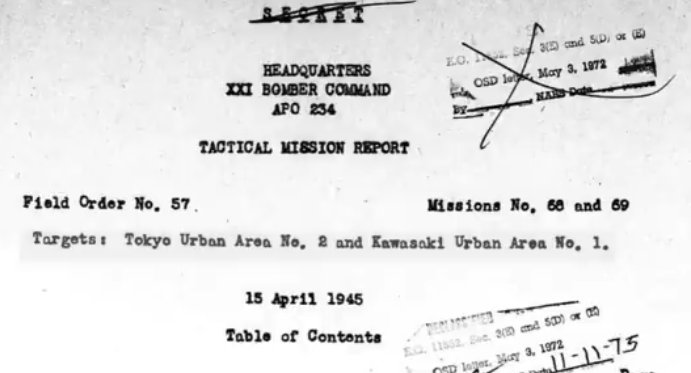
|
HEADQUARTERS
XXI BOMBER COMMAND
APO 234
Field Order No. 57.
Missions No. 68 and 69
Targets: Tokyo Urban Area No. 2 and Kawasaki Urban Area No. 1.
15 April 1945
Mission 68 was performed by 111 B-29's of the 313th Bomb Wing and 108 B-29's of the 314th Bomb Wing.
Mission 69 was performed by 118 B-29's of the 73rd Bomb Wing.
The first takeoffs, except for pathfinders that took off before the main forces, were at 06:50 Zulu time, the last takeoffs at 09:24 Zulu time, i.e. from 02:50 p.m. local time to 05:24 p.m. local time:
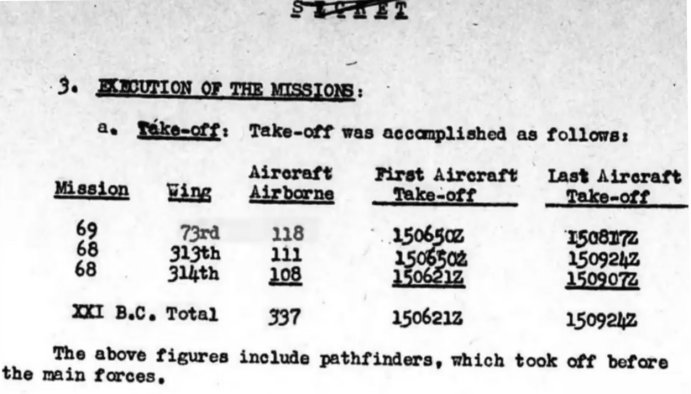
|
The “Enemy Opposition” section of the report included a part titled “Balls of Fire”:
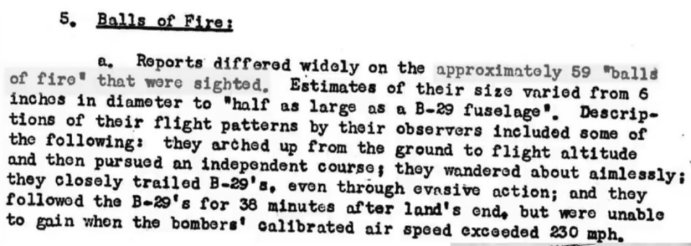
|
5. Balls of Fire:
a. Reports differed widely on the approximately 59 “balls of fire” that were sighted. Estimates of their size varied from 6 inches in diameter to “half as large as a B-29 fuselage”. Descriptions of their flight patterns by their observer included some of the following: they arched up from the ground to flight altitude and then pursued and independent course; they wandered about aimlessly; they closely trailed B-29'a, even though evasive action; and they followed the B-29's for 38 minutes after land's end, but were unable to gain when the bombers' calibrated air speed exceeded 230 mph.
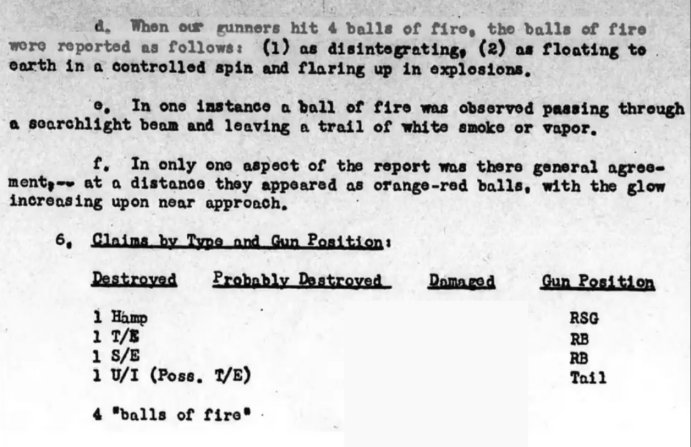
|
d. When our gunners hit 4 balls of fire, the balls of fire were reported as follows: (1) as disintegrating, (2) as floating to earth in a controlled spin and flaring up in explosions.
e. in one instance a ball of fire was observed passing through a searchlight beam and leaving a trail of white smoke or vapor.
f. In only one aspect of the report was there general agreement, -- at a distance they appeared as orange-red balls, with the glow increasing upon near approach.
6. Claims by Type and Gun Position:
| Destroyed | Probably Destroyed | Damaged | Gun Position |
|---|---|---|---|
| 1 Hamp | RSG | ||
| 1 T/E | RB | ||
| 1 S/E | RB | ||
| 1 U/I (Poss. T/E) | Tail | ||
| 4 “balls of fire” |
[Ref. 9bg1:] 9TH BOMB GROUP, 313TH BOMB WING, WAR JOURNAL:
April 15-16, 1945 - Swiftly we followed up our second big raid on Tokyo with a blow the next night, at the adjoining city of Kawasaki. This was our toughest, as well as our costliest, mission. Over fifty enemy aircraft were encountered. Approximately a dozen 'Balls of Fire' were sighted by our crews. With over 300 aircraft going over the target, the danger of mid-air collision was ever-present. The antiaircraft fire was both accurate and intense. We were in it longer, too. Heat thermals, one of the serious perils on these raids, were unusually severe. There were thirteen aircraft lost in the Bomber Command. Four of them were ours.
The Boeing B-29 “Superfortress” was the heaviest bomber of the U.S. Army Air Forces, used in operations from May 8, 1944 and on. Its maximum speed was 574 km/h.
Its defensive armament was 12 Browning M2 12.7 mm machine guns.
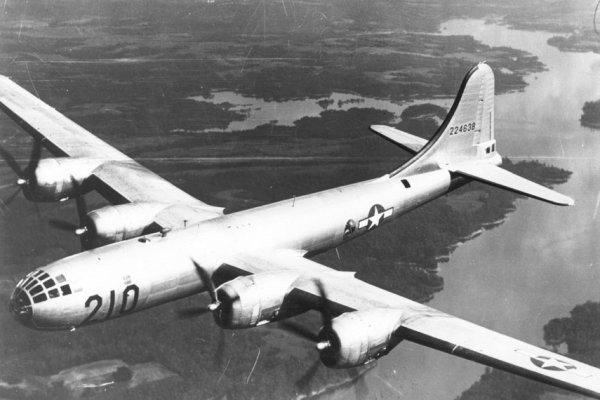
|
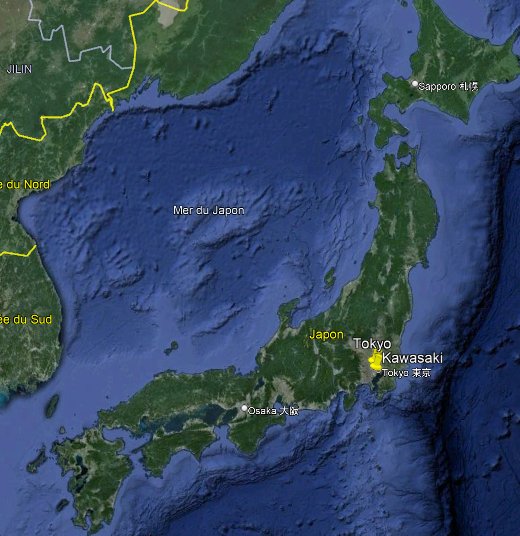
|
Some preliminary remarks: the report indicates 59 “balls of fire” observed; but it must be borne in mind that several crews could have observed the same balls of fire and that there could therefore have been fewer than 59.
The report classifies these “phenomena” in a very separate category, not that of Flak, nor that of rockets, nor that of searchlights, nor that of enemy planes. This means that at the time at least, what these “balls of fire” were was unknown.
The one showing a smoke trail when in the beam of a searchlight could well have been a rocket, or a phosphorus bomb such as the Japanese fired or dropped onto the B-29s.
The remark on the size reported with considerable variations should not surprise a ufologist. For an object of unknown nature, if there is not a circumstance such as a background at a known distance, it is not really possible to give a credible real size. As all these reports are cumulative, it is now impossible to discuss the size of these “balls of fire.”
What were these “balls of fire?”
It is really tempting to say that it was all just air-to-air phosphorus bombs, enemy planes equipped with searchlights - the Japanese did this to designate B-29s to ground anti-aircraft defenses by illuminating them - anti-aircraft rockets coming from the ground, which seems to be the case for some of these “balls of fire”, and other fireworks of the usual Japanese anti-aircraft pyrotechnics.
What sows doubt in my mind is that:
1) These “balls of fire”, like the “Foo-Fighters” of the European theater during World War II, do not seem to have attacked any of the B-29s. This makes no sense, especially for those described as approaching a B-29 or following it for 38 minutes. There is no sense in which an approaching weapon would not end its trip by hitting the B-29. It also makes no sense for a Japanese pilot to follow a B-29 for 38 minutes strictly for nothing, knowing that a major problem with Japanese aviation was fuel shortage.
2) Subsequent U.S. Army Air Forces analyzes of the “balls of fire” note that they do not attack, and conclude that “the mystery remains unsolved.”
Certainly, I have a hard time finding that these balls of fire here would necessarily be “extraterrestrial spacecraft”, but I have no answer to this mystery, at least in these cases of the April 15, 1945 missions.
Rockets and unidentified.
* = Source is available to me.
? = Source I am told about but could not get so far. Help needed.
| Main author: | Patrick Gross |
|---|---|
| Contributors: | None |
| Reviewers: | None |
| Editor: | Patrick Gross |
| Version: | Create/changed by: | Date: | Description: |
|---|---|---|---|
| 0.1 | Patrick Gross | June 16, 2024 | Creation, [aaf1]. |
| 1.0 | Patrick Gross | June 16, 2024 | First published. |
| 1.1 | Patrick Gross | July 19, 2024 | Addition [9bg1]. |